Human Anatomy & Physiology Combined Review – Flashcards
Unlock all answers in this set
Unlock answersquestion
Homeostasis
answer
the ability of the body or a cell to seek and maintain a condition of equilibrium or stability within its internal environment when dealing with external changes
question
Superior
answer
Above
question
Inferior
answer
Below
question
Proximal
answer
Closer to the point of attachment
question
Distal
answer
Farther away from the point of attachment
question
Caudal
answer
situated in or directed toward the hind part of the body
question
Cranial
answer
of or relating to the skull or cranium
question
Dorsal
answer
located near, on, or toward the back or posterior part of the human body
question
Lateral
answer
located away from the midline of the body
question
Medial
answer
located close to the mideline of the body
question
Metabolism
answer
the chemical reactions involved in sustaining the life of an organism
question
Midsagital
answer
divides the body into left and right sides
question
Thoracic
answer
cavity located in the chest. Contains the esophagus, trachea, bronchi, lung, heart and large blood vessels
question
Transverse Plane
answer
divides the body into a top half and a bottom half
question
Ventral
answer
front or anterior
question
Pelvic Caity
answer
Contains the urinary bladder, the reproductive organs, and the last part of the intestines
question
Spinal cavity
answer
Contains the spinal cord
question
Cells
answer
smallest unit of life
question
Cell Membrane
answer
the outer protective covering of the cell
question
Centrosome
answer
the centriole containing region of clear cytoplasm adjacent to the cell nucleus.
question
Cytoplasm
answer
the material or protoplasm within a living cell, excluding the nucleus
question
Cytokinesis
answer
the division of the cytoplasm of a plant or animal cell into two
question
Endoplasmic Reticulum
answer
network of interconnected structures that function especially in the transport of materials within the cell.
question
Genes
answer
the structures that carry inherited characteristics
question
Golgi Apparatus
answer
a cytoplasmic organelle that consists of a stack of smooth membranous saccules and associated vesicles and that is active in the modification and transport of proteins.
question
Glycolysis
answer
the breakdown of glucose inside of the cell
question
Lysosomes
answer
a saclike cellular organelle that contains various hydrolytic (digestive) enzymes
question
Meiosis
answer
form of celluar reproduction specific to sex cells in all sexually reproducing single celled and multicelled eukaryotes
question
Mitochondria
answer
found outside the nucleus. Responsible for producing energy for the cell through the breakdown of carbohydrates, proteins, and fats
question
Mitosis
answer
form of cellular reproduction that occurs in the nucleus of a dividing cell resulting in the formation of two new nuclei each having the same number of chromosomes as the parent nucleus
question
Nucleus
answer
control center of the cell
question
Organ
answer
a differentiated structure (as a heart or kidney) consisting of cells and tissues and performing some specific function in an organism.
question
Organelles
answer
a specialized cellular part (as a mitochondrion or ribosome) that is analogous to an organ
question
Tissues
answer
many cells usually of a particular kind (i.e. connective, epithelium, muscle, and nerve are types)
question
Integumentary System
answer
the organ system that provides protection to the outer body
question
Epidermis
answer
the outermost layer of the skin
question
Dermis
answer
the second layer of the skin composed of an elastic connective tissue, blood vessels, lymph vessels, nerves, involuntary muscle, hair follicles, sweat and oil glands
question
Hypodermis
answer
also known as the subcutaneous fascia is the inner most layer of the skin consisting of connective tissue and adipose (fatty tissue)
question
Sebaceous glands
answer
oil glands
question
Sudoriferous glands
answer
sweat glands
question
Appendicular skeleton
answer
portion of the skeleton forming the extremities composed of the shoulder girdle, arm bones, pelvic girdle and leg bones
question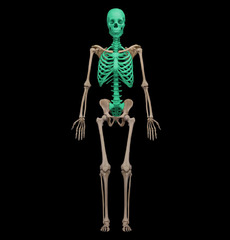
Axial skeleton

answer
portion of the skeleton forming the main trunk of the body composed of the skull, spinal column, ribs, and breastbone
question
carpals
answer
wrist
question
clavicles
answer
collarbones
question
cranium
answer
skull
question
diaphysis
answer
shaft of a long bone
question
endosteum
answer
the layer of vascular connective tissue lining the medullary cavities of bone and keeps the yellow marrow intact
question
epiphysis
answer
end of a long bone
question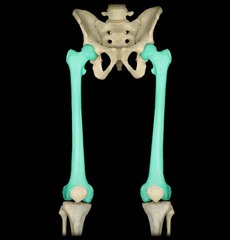
femur

answer
thigh, longest and largest bone in the human body extending from the hip to the knee
question
fibula
answer
the smaller of two bones of the lower leg below the knee
question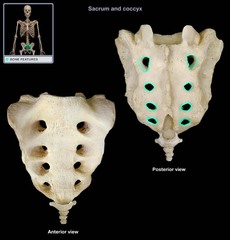
foramina

answer
openings in bones that allow nerves and blood vessels to enter or leave the bone
question
humerus
answer
the longest bone of the upper arm extending from the shoulder to the elbow
question
joints
answer
an area where two or more bones join together
question
ligaments
answer
a tough band of tissue that connects long bones together at joints
question
medullary canal
answer
the marrow cavity of a bone
question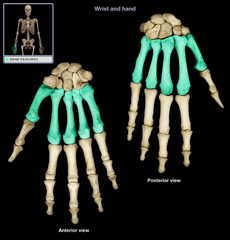
metacarpals

answer
the five bones forming the palm of the hand
question
metatarsals
answer
the five bones forming the instep of the foot
question
patella
answer
kneecaps
question
periosteum
answer
tough membranous outer covering of bone
question
phalanges
answer
fourteen finger bones ( three bones comprising each finger and two on each thumb.)
question
radius
answer
smaller of two bones of the lower arm located on the thumb side
question
ribs
answer
12 pairs of bones attaching to the thoracic vertebrae on the dorsal surface of the body
question
scapula
answer
shoulder bone
question
skeletal system
answer
system made of 206 bones and functions as the framework for the human body
question
sternum
answer
breastbone, connects with the clavicles and the cartilages of the upper seven pairs of ribs
question
Tarsals
answer
the seven bones forming the ankle
question
Tibia
answer
the inner and usually larger of the two bones of the leg between the knee and ankle
question
Ulna

answer
the bone on the little-finger side of the human forearm that forms with the humerus the elbow joint and serves as a pivot in rotation of the hand
question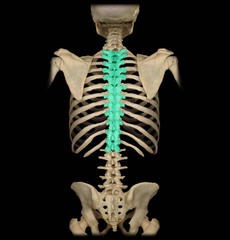
Vetebrae

answer
the 26 bones forming the spinal column
question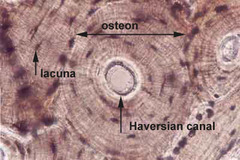
Osteocyte

answer
a bone cell
question
A-band
answer
area where actin and myosin overlap
question
Actin
answer
a muscle protein; major component of the I-band and helps to compose the thin filaments
question
Cardiac muscle
answer
the principal involuntary-muscle tissue of the vertebrate heart made up of striated fibers joined at usually branched ends and functioning in synchronized rhythmic contraction
question
Cramp
answer
a painful, involuntary muscle contraction, usually caused by fatigue or strain
question
involuntary
answer
a type of muscle that contracts without conscious control
question
Myocyte
answer
muscle cell
question
Myofibril
answer
located within the muscle cells; composed of thick (myosin) and thin (actin) filaments
question
Myosin
answer
a muscle protein; major component of the A-band; thick filaments
question
Muscle
answer
a tissue that has the ability to contract to help with movement
question
Muscle contraction
answer
when the sarcomere shortens and the Z-lines move closer together
question
Sacromere
answer
basic unit of muscle contraction; segment between two neighboring Z-lines
question
Skeletal muscle
answer
striated Muscle that is attached to the bones of the skeleton and is usually under voluntary control
question
Sliding filament theory
answer
theory that explains how sarcomeres contract; myosin filaments use energy from ATP to "walk" along the actin filaments with their cross bridges; myofilaments slide past one another and contract the myocyte
question
smooth muscle
answer
muscle tissue that lacks cross striations, is made up of elongated spindle-shaped cells having a central nucleus, and is found especially in vertebrate hollow organs and structures (as the digestive tract and bladder) as thin sheets performing functions not subject to direct voluntary control
question
sprain
answer
an injury to the joints caused by overstretching
question
strain
answer
an injury to the muscle caused by overstretching
question
superficial muscles
answer
muscles that are located in the layer closest to the skin
question
tendon
answer
a tough piece of tissue in your body that connects a muscle to a bone
question
visceral muscle
answer
smooth muscle found in the digestive, respiratory and circulatory systems
question
voluntary muscle
answer
a type of muscle that is controlled by the individual, such as the striated muscle
question
deoxygenated blood
answer
blood that is poor in oxygen
question
oxygenated blood
answer
blood that is rich in oxygen
question
speak
answer
following the removal of a larynx, what would a person be unable to do
question
skin and mucous membranes
answer
the body's first line of defense against the invasion of disease causing microorganisms
question
B lymphocytes
answer
the type of cells that produce antibodies
question
Human Immunodeficiency Virus (HIV)
answer
virus that attacks white blood cells and destroys them
question
right atrium
answer
#1 on the photo
question
right ventricle
answer
#2
question
left atrium
answer
#3
question
left ventricle
answer
#4
question
aorta
answer
#6



